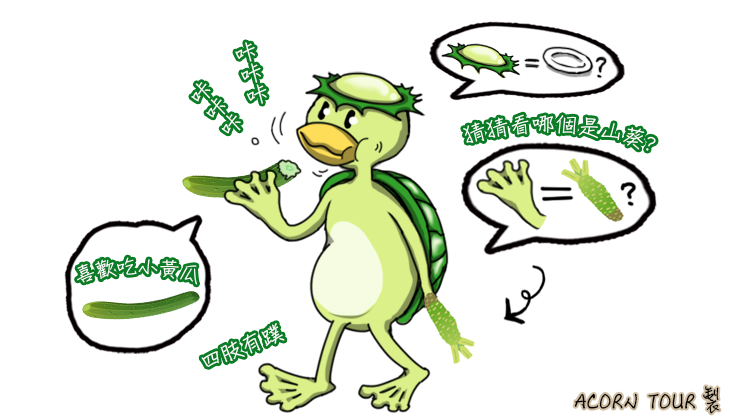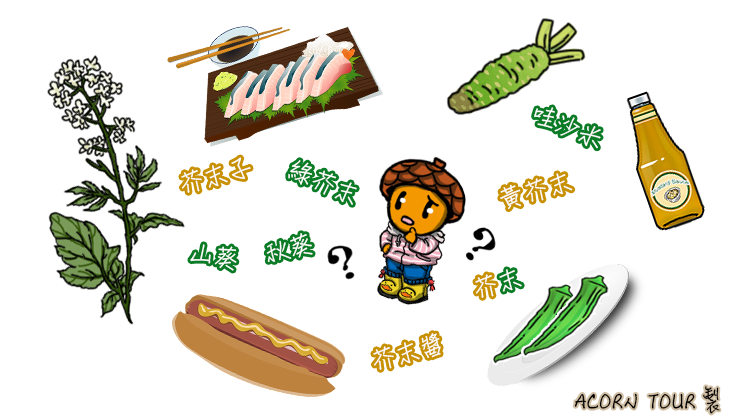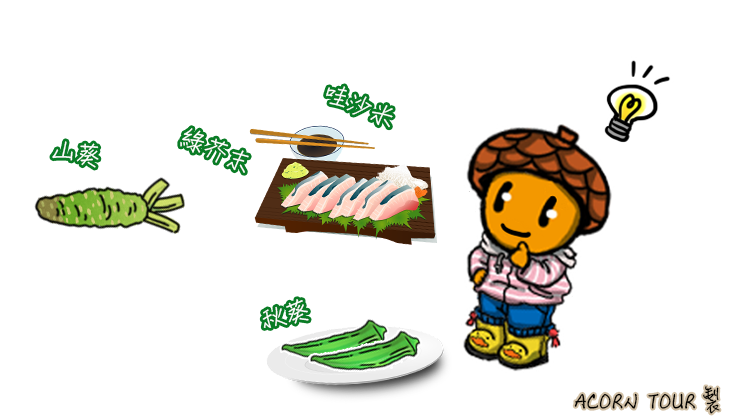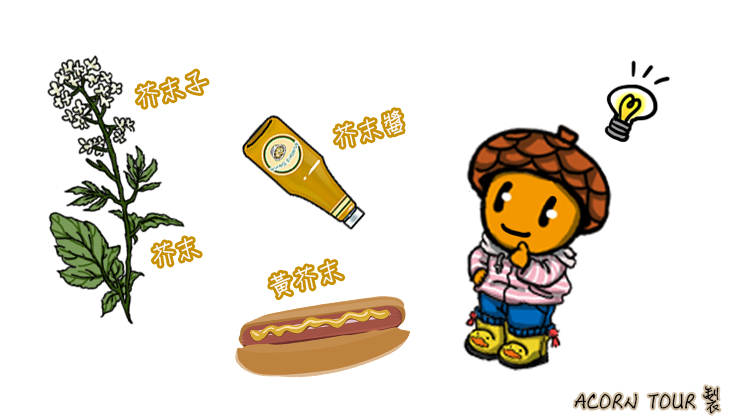Once we traveled to the countryside in Kyushu, Japan, and encountered an old chief of the village, who was promoting that children would survive in the natural eco-environment. He talked about his childhood adventure.
【連結至中文版】
The mysterious creature legend of Japan.
Tour of the origin of the Kappa and survival
The origin of the Kappa, it is said that there is a related description record in 《Compendium of Materia Medica》, where was lived in the Hubei area of the monster as called Hebo or Shuihu. Later, it was named "Kappa" when the legend was spread to Japan. The name "Kappa" in Japan becomes softy; however, another name is to call "Hebo"[1] with a little awe which is similar to the deity of a river.
[1] “Hebo” is a Chinese name and pronunciation that "He" means a river and "bo" is like an uncle or calls the elder man in Chinese.
The Kappa was written in the 《Compendium of Materia Medica》! Could it be that humans ate them as medicinal materials during the Ming Dynasty? Hence, they escaped from humans by boats or swimming all the way to Japan. But when they had arrived in Japan they got various hurt because they were misunderstood by the locals causing the species wars. After that, they decided to hide and would not dare to live in groups because they were worried about being discovered.
Humans hurt those creatures again for lifetime extension and occupied the land.
We speculate that the migration of Kappa possibly followed the river from the Hube in China to the Yangtze Basin and arrived at the estuary, where was located nearly in Kyushu, Japan in a relative direction. There are legends and traces of Kappa in Kyushu's north, middle, and south. The rivers in the south and middle of Kyushu (Kuma River and Kurume River) also have kappa legends as well as the unknown small river in the north.
There was unexpectedly a Sake Kappa in this unknown river. What is a Sake Kappa? Did the Sake Kapa, who was good at making sake, open an ancient distillery? Or was it a Sake brand that the Kappa love to drink? Or was there a Kappa in a sake?
The answer is ...
【TOUR】
![]() [Island hopping tour in southern Japan.]
[Island hopping tour in southern Japan.]
This migration route goes towards a mountain area in the middle of Honshu, where is the deities' hometown in legends. The river is very clean, and it is said that kappa appeared once; therefore, a bridge is named "Kappa Bridge" here. The Kappa slowly moved to the north to the mountain area of the northeast of Honshu. Discovered the ceremony of fishing Kappa still has been existed here. Lastly, came to the Toyohira River in south Hokkaido, and there was a female kappa to capture a human as a husband.
It is said that there are the mummy of the Kappa and mermaid as a collection in the ancient temple in Japan now. It is not easy to find out the truth.
Encounter with a Kappa.
 【The little story 01】
【The little story 01】
The local guide of Japan talked about such an experience once.
He said, one day when they were touring in the Toyohira River, a member of the group suddenly came to him and told him that he had seen a Kappa. He said, indeed, the legend hands down that many residents had seen the Kappa in here; however, no one knows it truth or not. Maybe this member of the group looked forward to seeing the Kappa as well as us. It must be a very novelty if we can see with our own eyes, whether or not it's true. Remember to bring a bag of cucumbers as a gift for making up for them when you will go next time. To express our friendliness and let them reduce the fear of humans.
 【The little story 02】
【The little story 02】
.png)
.png)
Guess, where is the Kappa?
The answer: Page down.
.png)
.png)
Once we traveled to the countryside in Kyushu, Japan, and encountered an old chief of the village, who was promoting that children would survive in the natural eco-environment. He talked about his childhood adventure.
One day his uncle and he were picking wasabi on the very clear river bank. Suddenly, he felt a heavy hit behind his back when they had driven back home after the picking, as someone hit hard from behind him. A fit of dizziness. Eventually, he was unconscious after he had slowly pulled over by willpower. He vaguely heard his uncle was calling him all the time. His uncle was very nervous and woke him up immediately. After a while, he gradually regained consciousness and soaked to the skin. (Even there was water in the driver's seat too.)
Afterward, they returned to the village and asked the elder in the village quickly what they experience. The elder said that they might have offended the kappa living in the river. Everyone discussed whether they were uncareful to step on the kappa’s feet or hands or head while picking wasabi. Therefore, did the Kappa play a trick on him?
The whole body was wetted if meets the Kappa in the legend. (PS, this is a legend in the countryside, not a ghost story.)
.png)
.png)
 【The little story 03】
【The little story 03】
Since from long time ago, Kappa-related legends have been spread throughout Japan, especially in Kyushu. As long as there are clean water sources and rivers, they will be there. An ancient book of 200~300 hundred years ago recorded there was a king of Kappas whose name was "Jiu Qian Fang" in the Warring States period. The king moved to the area of Kuma River with nine thousand Kappas for living. The kingdom of Kappa just turned over a new leaf but there was news that they abducted the local children or teased the local girls. (They might be misunderstood.) In fact, their behaviors were as well as humans. Some of nine thousand Kappas were a little naughty; moreover, it was just maybe happened that human beings fell into the stream at an accident. However, the kappas were been the allegation that they did everything.
Samurai Edo of the feudal lord in the Kumamoto Castle and a juvenile samurai fell into the creek exactly at that time. (Allegation of what Kappa did.) Could it be that he accidentally fell into the creek while he was playing at the bank of the creek? All allegations against the kappa had made the Samurai decided to eliminate the Kappa.
Strategic 1- First, it had poisoned at the upper reaches of the Kuma River where the Kappa living, like a poisoned fish.
Strategic 2 - The thousands of burning stones threw into the creek and prepared to stew them like a stone hot pot; however, Kappas did not surrender. This was a difficult war for Kappas because they almost suffered heavy casualties from humans' weapons and methods of injury.
Strategic 3 - To annihilate the Kappas at one time, the Samurai found Oreopithecus who were the Kappas feared the most! Oreopithecus of all Kyushu gathered at the Kuma River to support the Samurai. The King of Kappas had realized that the ship has sailed so that he surrendered. The king led the wounded Kappas to withdraw into the Chikugo River, where is the Kurume River today.
 【The little story 04】
【The little story 04】
The No. 47 of Japan ecological guide, who had read some of the reference literature.
Sharing as below,
1. The mischiefs had caused many troubles to people by Kappas, thus Kato Kiyomasa was furious about this. He commanded monkeys of all Kyushu to attack the Kappas. The Kappas had to surrender. They relocated to the Chikugo River after they had gotten permission and became messengers of the Kurume Suitentu.
2. The Kappas' stories were well known because the novels were famous for the theme of Kappas by 「Ashihei Hino」.
3. There is a bridge in Maekawa, and the vicinity of the bridge used to be called Tokubuchi no Tsu Harbor. It is a very bustling place where had been a maritime entrance of Yatsushiro City since the Middle Ages. There is a Kappa Introduction Monument nearby the bridge, which is made of a combination of two stones. The stones are called "ガワッパ", but why does name it?
The Tokubuchi no Tsu Harbor is a place where the Kappas arrived at the beginning. The Kappas who lived in Yatsushiro City got constantly into mischiefs. The arrested Kappas and people reached an agreement that was Kappas could not do any bad matters before these stones disappeared. But instead of it, the Kappas hoped in exchange for worship at once a year, and people agreed to this. Later, these stones were called urchin stones and heard they were used as bridge stones. The Kappas' Festival was called "オレオレデーライタ川祭り" which meanings are from many stories; however, someone said the meaning is "many people came from Wu State".
4. There is a temple of which called Goshinji Temple within the Yatsushiro Shrine. There are Kappas legends and festivals in this temple. Tanyoshi Ohara monk, who established the temple, felt his butt was stroked by a hand while he was going to the toilet one night.
The monk felt very strange, and later suddenly, that hand was broken while he was chanting Buddhist scripture. It is said that indeed was the Kappa's hand. A beauty, who lost a hand, went to the monk and begged him with crying to return the hand after every night.
PS: Was this real? The mischief was to stroke the monk's butt in the toilet. It felt a little stinking. This Kappa beauty was too naughty.
Her tears melted the monk's heart; hence, the monk made a deal with her that she must protect children who play in water and people who make papers take water for work from the harm within the depth river in front of the Goshinji Temple. The monk talked to her, " I will worship and put your favorite food on the river on 5th May every year if you comply with this agreement." Meanwhile, he returned that hand to her.
The Kappa Festival was on the 5th May of the lunar calendar to change to the first Sunday of June, and nowadays it still celebrates on that day. The leader of the gathered children shouted a special Japanese sentence after they had accepted the exorcism ceremony by the temple holding at noon. Afterward, they had swum to depth water of the opposite shore of the temple and erected a Gohei. The outside children could throw the hanging eggplants, cookies, or others on the bamboos into the river at the same time. This tradition is continuing by children's hands.
 【The little story 05】
【The little story 05】
A place is named "Lake Suwa" at the mountain of Unzen Onsen, it is said that a group of Kappa who lived there often got mischief into the local villagers. An eminent monk of the temple at this spring mountain knew this thing and decided to manage this group of Kappa. He had fought against the king of Kappa for three days and nights, and suddenly, he pretended to escape to the other side of the mountain. The king pursued him all the way. The king who had fallen for the monk's trap was following the monk into the spring area in the mountain. The round dish shape on the king's head was evaporated immediately by boiling gas and pungent sulfur. The king lost his supernatural power and surrendered at last.
 【The little story 06】
【The little story 06】
Having a clean water source is the most important condition for making the alcoholic drink factories. Many factories worship the water deity to have good water quality. There is a 300-year-old sake brewery, which has been passed down from generation to generation, "There is a precious treasure in our house."
But what is exactly that "treasure"? No one knew, but until one day a black wooden box was covered with thick dust was accidentally found on the collar tie roof by the 17th owner when the brewery was renovated. This box was with a mottled slip of paper, which was written "Hebo" on it. He opened it and took a look. He stood in amazement that he thought the original ancestral treasure was the Kappa from the ancient.
【Easy General knowledge 01】
There is an ancient Japanese book that was written by a poet in the Edo period about folklore. This book is similar to the Strange Tales from a Chinese Studio or literature.
Did the Kappa that crossed the ocean here come from the Kappa of China?
A man was named Senryo Kikuoka wrote the ancient Japanese book in 1746 in the Edo period, which mentioned the Kappa legends. The book said the kappa that came from the Yellow River area of China led their family here and resided in the Kuma River after eight generations.
PS, This is distinct from our inference that they went out to the sea from the Yangtze River. Which one is correct? Actually, there is no correct answer.
The proverb about Kappa.
The meaning is similar to “Hares may pull dead lions by the beard.”
【Easy General knowledge 02】
This year, the 33rd Kappa Myojin Summer Festival "Kappa Festival" was the same. The representative author 「Ashihei Hino」, who was born in the Kyushu established a「Kappa clan of Jiu Qian Fang Motoyama Tanushimaru」to protect the Kappa's features of Tanushimaru town. There will be held the worship ceremony, releasing carps, and other activities on the day of the festival on August 8th every year. Fans who love Kappa from all over will go here to participate in this annual festival; therefore, some people are still friendly to Kappa. It expresses the protection of rivers and favorite Kappa by this festival. Believing that Kappa secretly observe this or also hold a small festival.
【Easy General knowledge 03】Kappa, Wasabi, and Sake.
Guess, what is the relationship between kappa, wasabi, and sake?
The answers are as below,
(1)They all need clean rivers and water sources.
*Cleaning rivers produce good quality rice. Brewed Sake must have clean water and good quality rice that will produce tasty Sake.
*Eating cucumbers makes some "ka" sound because Kappa love to eat cucumbers. Hence, the Japanese name of Kappa has a "Ka" tone. It is said that the round dish shape on the Kappa's head has to keep moisture so that they will not sick. That is the reason the Kappa always lived nearby the water sources of the clean rivers.
*Wasabi has to grow on the river's bank of clean water sources too.
(2)The bottles of the Kappa, Wasabi, and Sake are all green.
(3)The roots of wasabi look like as the Kappa's fingers.
(Are the reasons possible the Kappa's fingers look like roots of wasabi and heads look like leaves of wasabi as a result that humans step on their hands and then heads? )
(4)Japanese like to turn the favorite food of mythical animals into sushi.
For instance,
Kappas love to eat cucumbers so the sushi with cucumbers is called "Kappa Sushi" by Japanese.
Foxs of Inari shrines love to eat tofu skin so the sushi with tofu skin is called fox sushi or Inarizu sushi.

【Easy General knowledge 04】What is the difference between wasabi, okra, and mustard?

▲OKRA
The Compendium of Materia Medica records that the native species of okra grows in Africa which was introduced by India in the 20th century. Okra is good for the stomach and recovery. Okra is good for the stomach and recovery; moreover, it is the favorite food for the Japanese.
▲Wasabi
Natural wasabis only grow in a place where the water source is clean and without any pollution. It produces nearby the stream or mountain in Japan and Taiwan. The primary function of grated natural wasabi has an antimicrobial effect on eating raw seafood. Wasabi is made into ice cream in the Izu Peninsula, Japan. Wasabi has three spicy flavors which are hot, medium, mild. Wasabi is Japanese pronunciation.

▲Mustard
Yellow mustard is a condiment made from the seeds of a mustard plant, and it is different from Japanese Wasabi. It is the sauce for the meat by a way of the western countries. Among them is a seed-style mustard sauce which is made of mustard seeds and produced from Dijon France. Dijon mustard originated in 1856 when Jean Naigeon of Dijon replaced the usual ingredient of vinegar with verjuice, the acidic juice of unripe grapes. It is called Dijon mustard due to in Dijon.
Truly natural seed-style mustard has the brown grain (containing the whole mustard seeds) not very pungent. Seed-style mustard has a distinct flavor and taste because it contains different kinds of whole mustard seeds and is mixed with spices.
▲American & French Dijon Mustard Sauce
American Mustard Sauce: Generally, the ingredient contains mustard, water, salt, chili powder, turmeric, vinegar, etc that become a condiment.
French Mustard Sauce: It contains mustard seeds. Authentic Dijon mustard sauce is made from white and Bourgogne wine with acidic juicy grapes instead of vinegar.

 【Little Story 01】Japanese Wildman
【Little Story 01】Japanese Wildman
.png)
There was a very wonder encounter at Hibagon Saijocho where was a probable location in the Chugoku region (It is called five prefectures, which are Okayama, Hiroshima, Yamaguchi, Tottori, and Shimane as a name.) of Japan in the 1970s. A resident, Mr. Maruzaki, accidentally saw a creature was passing in front of him which he had never seen before. He thought it was a giant chimpanzee; however, this monster slowly walked while it was looking in the direction of Mr. Maruzaki. And then it disappeared into the depth forest. In the beginning, it was debated what happened by the villagers. But a farmer, Mr. Imafuji, who lived nearby a dam, also saw the creature while was weeding nearby his home after three days of that incident. He said he considered that was a human; however, it was distinct from humankind. The height of this strange creature is as well as human, although it felt a bit peculiar. However, it also was a bit as same as humankind. They called this strange creature "HIBAGON" according to the pronunciation of Mount Hiba. The District Office had paid attention to these consecutive sightings and established the Ape Countermeasures Committee. The Simiidae Department was established the following year.
The major businesses of the Simiidae department are to promote the tourism of the town, offer the consultation and information of the strange creatures, guide the place of the incident, collect the witness information, offer the help of the exploring team, etc. Eventually, there had received tips about 100 sightings until the commotion calmed down. 22 of these reports were testimonies from the mouths of 33 different people whose words were considered "highly credible, to be believed as facts".
Observed the following commons from those testimonies,
・The height is about 150 ~ 170 centimeters, and the weight speculates about 80 ~ 90 kilograms.
・Its face is like an inverted triangle and has piercing eyes.
・The whole body is covered with light black hair close to brown. The meeting places of hairs are inverted.
・Its action is slow, harmless, and not afraid of humans.
Talking of the unknown creatures, it may come to mind is "Yeti of the Himalayas", "Bigfoot of the USA", "Almas of Mongolia", " Wildman in China", and so on. Was it a little shorter of the HIBAGON's height than compared to those others? Nevertheless, it was much bigger than the Japanese macaque.
Afterward, someone speculated it might be a chimpanzee, and it might escape to nearby Mount Hiba from the zoo. But there was not any report which had any animals escaped from the zoos where nearby that area. Most people believe that HINAGON is an ape. Those witnesses usually saw many monkeys, thus they considered that absolutely not a monkey. Even though others still considered that was a monkey. Therefore the angry witnesses were not willing to offer any testimonies anymore.
Nobody would like to continue to research after that because many people did not care about this. It is the reason why there are so few legends about HIBAGON's.
【TOUR】
![]() [Islands hopping of fishing villages tour in southern Japan.]
[Islands hopping of fishing villages tour in southern Japan.]
【to be continue … 待續】
2018/08/06
【著作權聲明】
本站所刊載之所有內容,除著作權法規定不得為著作權之標的(如法律、命令、公務員撰擬之講稿、新聞稿等...請參考著作權法第9條規定)外,其他包括文字敘述、攝影、圖片、錄音、影像及其他資訊,均受著作權法保護。任何人未經原作者同意不得盜用、複製、轉錄、散佈部分或全部內容。
【Copyright Notice】
All content published on this site that except the items shall not be the subject matter of Copyright Act that such as laws, orders, the text of speeches, news releases, etc., please refer to the Article 9 provisions of Copyright Act the others all protected by Copyright Act including textual narratives, photography, pictures, sound recordings, images, and other information. No one may misappropriate, reproduce, transcribe, or distribute part or all of the content without the consent of the original author.


